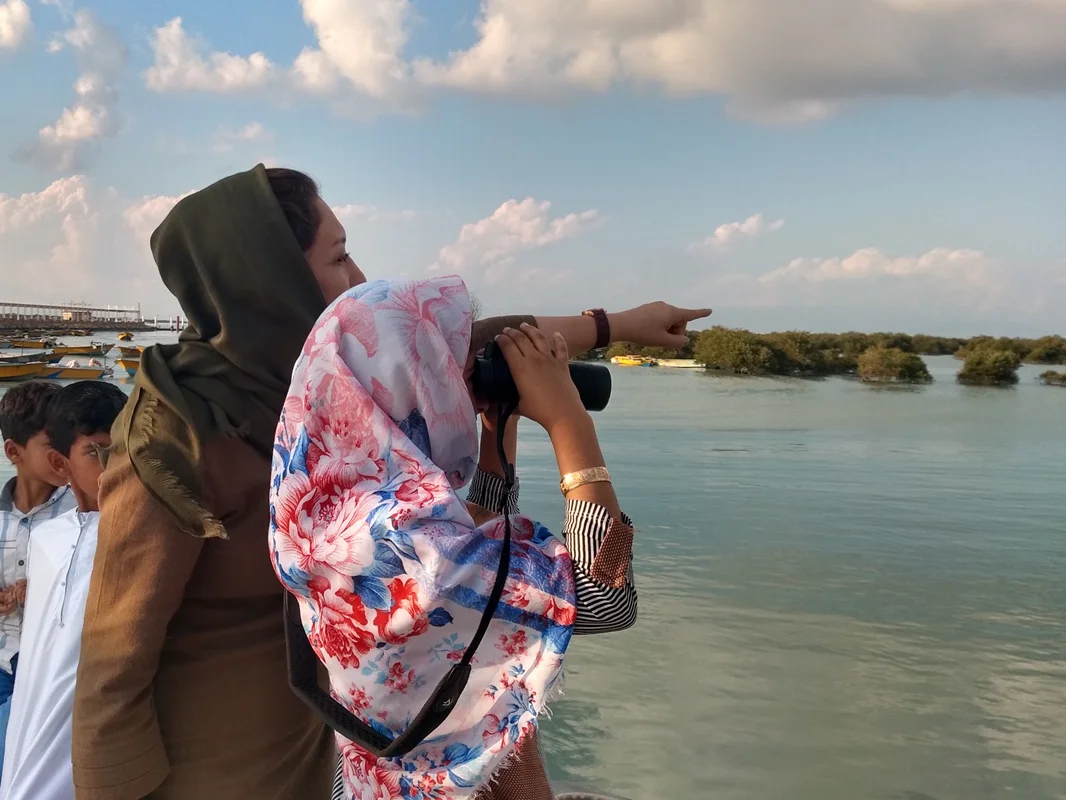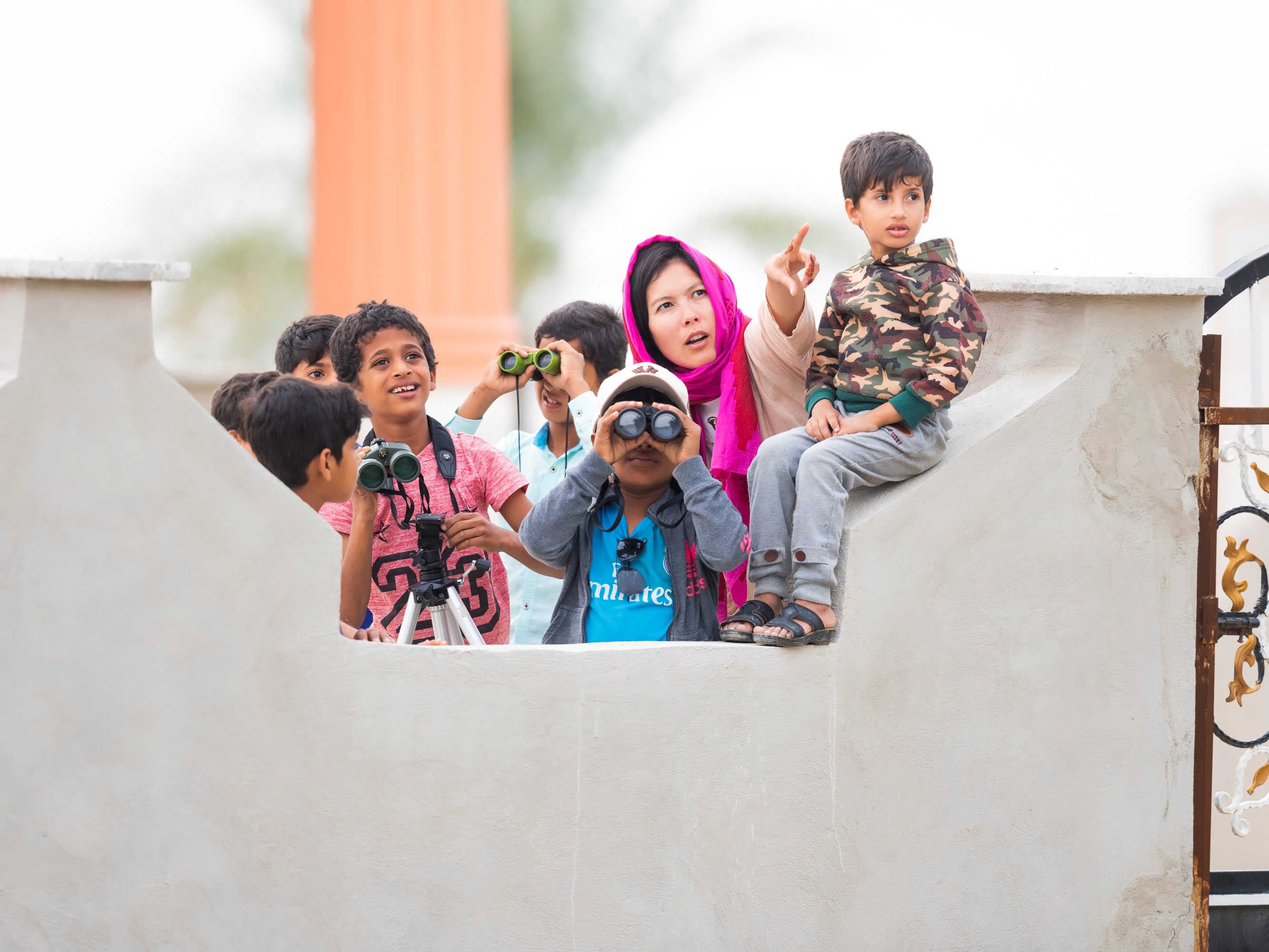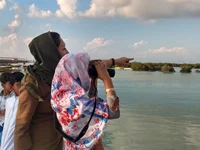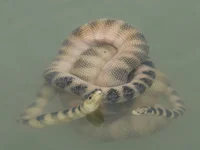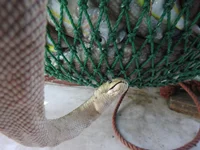Local children and birds in Hara Biosphere Reserve
Duration: December 2019
Type: Education and rising awareness + Direct conservation actions
Taxon: Birds
QECI's Role: Lead Investigator
Partners: The municipalities of the Dehkhoda, Gavarzin, Haftrangoo, Soheili and Tabl villages; and also:


Sponsor:
More than a hundred bird species forage, breed and roost on the mangrove trees and the mudflats of the Hara Biosphere reserve, where with an area of about 8000 km2 is known as the largest mangrove forest in the Persian Gulf. This vast coastal wetland hosts more than 55 aquatic bird species, of which some of them, such as Eurasian curlew, Numenius arquata, and Socotra cormorant, Phalacrocorax nigrogularis, are considered as threatened by IUCN. Hence, this wetland is known as a Marine Important Bird Area (MIBA), and a Megadiversity Place in the Middle East (ref). Nonetheless, anthropogenic activities, mainly ecotourism, is quickly expanding in this region, and therefore a sustainable future for this rich ecosystem depends on a responsible development. Therefore, if the next generations living around these wetlands have enough knowledge, and sufficient motivation for nature conservation, the development process in this valuable habitat could be sustainable.
- Youngsters of villages lying at the northern margin of Hara Biosphere reserve, participated in an educational program with the aim of introducing next generations to the importance of biodiversity conservation. We first designed a one-day program, then divided all participants into several groups (each one with maximum 40 children) and ran the program for each of them on a separate day. The aim was to create a manageable educational environment so that each five youngsters were supervised by a facilitator on a full-time basis, and every child had enough time to learn use birding equipment such as binoculars and scopes.
To take a step toward this important goal, in December 2019, QECI held an educational program for children of the villages surrounding the Hara Biosphere Reserve, with the aim of introducing the next generation to the importance of biodiversity conservation, with special focus on bird diversity. This program was done under the slogan: “Save the Birds on Qeshm Island”.
Note: Adults who worked with children in this program were trained nature school’s facilitators, not teachers nor coaches. Actually, they did not teach or coach the children, because we believe due to their closeness to the natural habitats, the intact spirit of local children drives their eagerness for building an strong relationship with the nature, and we just need to facilitate that. The facilitators were responsible for the Children Safeguarding Code of Conduct, answering to their questions, training them when they ask, and supporting them when using available educational tools.
Young Birders
In this program, children experienced the use of birding equipment such as binoculars, scopes, field guides, etc., and could watch the birds of their surrounding environment from a shorter distance and in better detail than ever seen before.
- Using the appropriate equipment, and with the help of the facilitators, children could watch wild animals from a shorter distance than ever before.
Nest boxes for sparrows
The house sparrow, Passer domesticus, the small circumglobal passerine that mostly lives in urban and rural areas, are highly dependent on the holes of human-made buildings for nesting, and their nests in the natural environment are rarely seen. Therefore, in this educational program, we used house sparrows as a flagship bird species to teach children for caring for the birds in their houses for a longer period. A local carpenter made the pieces of wood for hundreds of nest boxes. Then, as a part of the program, we divided the children in five-person groups, each one very carefully supervised by a facilitator, and asked the children to assemble the boxes. Every child received a box and hung that on a tree/wall in her/his house using the help of an adult. Just few days after the project, we received the photos from the parents showing the boxes became occupied by the sparrows, creating a feeling of great satisfaction among the youngsters that they could make a home for a bird family :)
- In a collaborative work, children assembled the pieces of the nest boxes that had been cut using standard protocols, and then hung the nest on the walls and trees in their yards with the help of an adult. The aim was to welcome the house sparrows seeking an appropriate space for their nests and thus creating satisfactory feelings among the youngsters seeing that they could make homes for those little birds.
- A woody nest box occupied by house sparrows (the photo is from a yard in Dehkhoda village, and has low quality as it has been taken using a smart phone). Just a few days after the project, parents started to send us photos of the newly occupied nest boxes. We couldn’t be happier for the children that are now playing in the yards where they can frequently watch how a box that they made in few hours with their friends can make sparrows a home year after year!
Next generations, the best solutions for the plastic pollution
Due to the plastic crisis in the modern world, and to address the slogan of the World Migratory Bird Day 2019, “Be the Solution to Plastic Pollution”, we carried out this educational program without producing plastic debris. Further, at the end of the program all adults and children participated in plastic cleanup event. They collected all the plastic debris from the Sohieli Tourism Jetty lying at the northern Margin of the wetland!
- At the end of the program all adults and the children participated in a cleanup event to remove plastic debris from part of the wetland.
The migration game
Children love playing and almost everything they learn in their childhood comes forth from the games they learn to play. Therefore, we designed a game for the children through carefully addressing our Children Safeguarding Code of Conduct, which was carried out as a part of our educational program. The aim of this game was to promote the children to use their unbelievably productive and unique imagination for understanding many anthropogenic threats that birds face while they are migrating (a few examples include collisions with high glass buildings and electrical poles, illegal hunting, pollution, habitat destruction, etc.).
In the migration game, the youngsters, in the role of migratory birds, were instructed to travel between two points, and the adults, in the role of the anthropogenic barriers, gently tried to disrupt the journey of the little birds.
Children enjoying the migration game!
This program has been introduced as one of the events of the World Migratory Bird Day 2020. To see the event, click here.
This program has been introduced as one of the events of the World Wetlands Day 2020. To see the event, click here.



